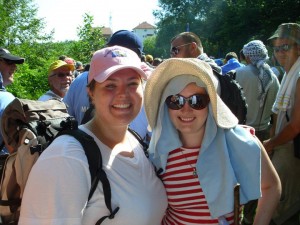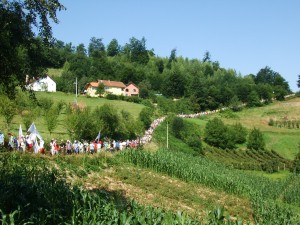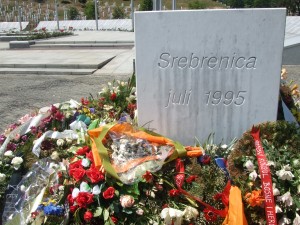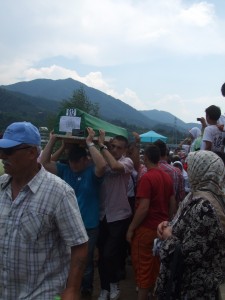Srebrenica is not only a town, but also a reminder of the worst atrocity during the Bosnian war. It is the town that suffered losses unimaginable to anyone who did not go through it. While it once was rich in natural resources, it has now become a struggling and mediocre façade of what it once was. The population was halved and only a handful of the bravest people returned to their hometown.
For the past few days, Julia (the other Advocacy Project Peace Fellow) and I have been interviewing women about their needs and wants for the new BOSFAM center in Srebrenica about what services they use, what they would use, what they need, etc. One question that I look forward to hearing the response to is: why did you come back to Srebrenica? With the everlasting memory of your closest relatives buried deep in a cemetery in Potocari, the past is haunting. Houses are overtaken by trees and stray dogs. Graves litter the hillside. Buildings lie empty. Almost without exception, each woman, no matter her age, always answers the question in the same way. Srebrenica is my home. It is my town and I will not let someone else’s stupidity ruin the place where my best memories are. Each time, I am stunned by the deep connection that this now small town has instilled in so many. What makes it so special?
Last week I spent the night at an international peace camp in the Bosnian wilderness. I had expressed interest in seeing the camp and soon thereafter I was promptly gathered and placed into an old jalopy with two strangers and was racing up a dirt road in the middle of nowhere. On one side of us was a vertical wall of a mountain and below us I could see the biggest canyon in Europe with a green river that snaked through the lush green mountains. The view was breathtaking.
The camp was a collection of 10 UNHCR tents and a few wooden structures and no one around for miles. I was in awe of the pure natural beauty and simplicity of what stretched out around me for as far as I could see. At night as we sat around a fire of freshly chopped wood, I was stunned and humbled by the sheer number of visible stars above me.
I started a conversation with the camp’s owner and my chauffeur, Hakija. He told me that he started the camp for two reasons: to initiate a dialogue between the Serbs and Bosnian Muslims and to reinstate Srebrenica’s fame as a tourist destination in the Balkans and beyond. He explained that because this was the first year of its operation, dialogue was not something to be pushed, but rather a latent, secondary goal for now.
Drinking homemade milk and sitting on the edge of the Drina River, I finally understood the point that Hakija was trying to prove. Srebrenica is beautiful. The land is home to some of the best berries I have ever tasted, the dirt houses minerals such as zinc and silver, and there is even a spring with waters that are famed to have healing powers – a few decades ago, this potent and mineral-rich water was bottled and sold in stores throughout the former Yugoslavia. Most importantly, the local people I have met have been extremely kind and warmhearted.
As I near the end of my summer in Bosnia, I wonder why I haven’t spent more time in this town. The first time I visited, I came for a few hours to meet the women who work here and then went back to Tuzla. The second time, I was here to remember the 8,000 lives that were taken from Srebrenica.
After my hike up to the Crni Guber to partake in the power of the magical waters and the rest of my experiences here, I understand. I can see what drew people to this town. While there isn’t the hustle and bustle of the silver mining town from the past, there is a semblance of the vibrant community beneath the surface but suffocated by a bloody reputation. Beneath the pain of families who endured rape and genocide, the soul of Srebrenica is struggling to stay alive and fights to not become a defunct ghost town. I hope that for Hakija’s sake and for Srebrenica’s sake people will see the town of Srebrenica for what it is and not for what it was.





